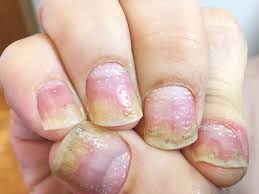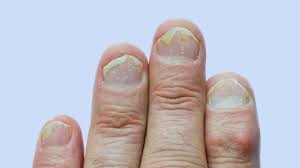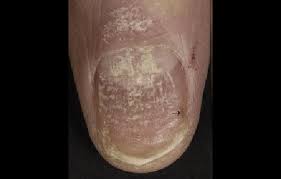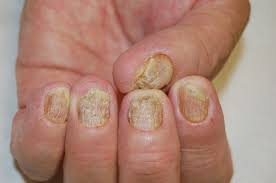



Psoriatic onychodystrophy
Psoriatic onychodystrophy or psoriatic nails is a icommon nail disease in those with psoriasis, with reported incidences varying from 10% to 78%.
Elderly patients and those with psoriatic arthritis are more likely to have psoriatic nails.
Characteristically, psoriatic nails are characterized by a translucent discoloration in the nail bed.
The changes resemble a drop of oil beneath the nail plate.
Other early signs include thickening of the lateral edges of the nail bed with or without resultant flattening or concavity of the nail; separation of the nail from the underlying nail bed;
thin streaks from the tip-edge to the cuticle; sharp peaked roof-ridge raised lines from cuticle to tip; separation of superficial layers of the nail followed by loss of patches of these superficial layers, leaving thin red nails beneath; or nail pitting–punctate changes along the nail plate surface.
The causes of nail psoriasis are unknown.
The Nail Psoriasis Severity Index (NAPSI) and modifications:
It evaluates several signs separately, each on a 1–3 scale: pitting, Beau’s lines, subungual hyperkeratosis and onycholysis.
Treatment:
include topical, intralesional, radiation, systemic, and combination therapies.
Tacalcitol ointment
Clobetasol nail lacquer and tacalcitol ointment
5-fluorouracil
Calcipotriol
Calcipotriol plus betamethasone dipropionate ointment
Efalizumab
Infliximab
Golimumab
Low dose methotrexate
Intralesional corticosteroid injection
Relative effectiveness of treatments
Infliximab appears to be the most effective treatment for nail psoriasis to date.
Low-dose systemic acitretin should be considered in the treatment of nail psoriasis.
Phototherapy uses ultraviolet light from special lamps and a drug called psoralen combined with ultraviolet A (PUVA) or ultraviolet B (UVB).
Laser therapy: a pulsed dye laser (PDL) can target the blood vessels under the nails, which may reduce the severity of nail psoriasis.
Laser therapy treatments usually occur every six months.
Aloe vera gel has anti-inflammatory properties that may relieve the symptoms of nail psoriasis.
Capsaicin creams or ointments may relieve the symptoms of nail psoriasis.
Curcumin has anti-inflammatory and anti-fungal properties that may relieve the symptoms of nail psoriasis.
